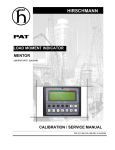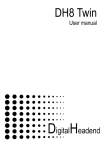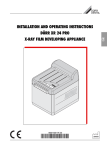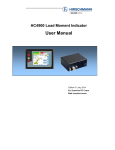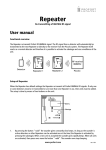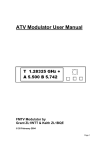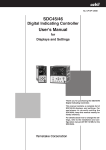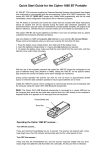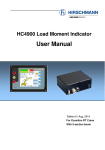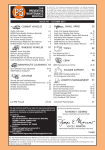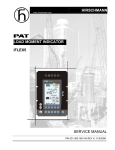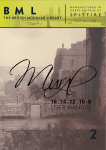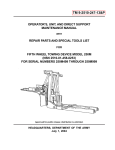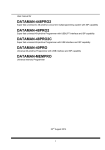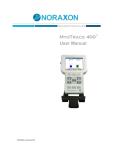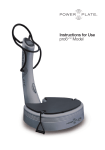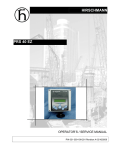Download Overload Warning System DS 50
Transcript
DS50 TROUBLE SHOOTING MANUAL LEVEL 3 Overload Warning System DS 50 Grove Trouble Shooting Manual Level 3 - Calibration Adjustments TSM DS 50-003/REV.B/031-300-190-003/12-02-96 1 DS50 TROUBLE SHOOTING MANUAL LEVEL 3 NOTICE The information in this document is subject to change without notice. PAT makes no warranty of any kind with regard to this material, including, but not limited to the implied warranties of merchantability and fitness for a particular purpose. PAT shall not be liable for errors contained in this manual or for incidental or consequential damages in connection with the furnishing, performance, or use of this manual. This document contains proprietary information which is protected by copyright. All rights are reserved. No part of this document may be photocopied, reproduced or translated to another language without the prior written consent of PAT. TSM DS 50-003/REV.B/031-300-190-003/12-02-96 2 DS50 TROUBLE SHOOTING MANUAL LEVEL 3 Table of contents Item 1. 1.1 1.2 1.3 2.1 2.2 3.1 3.2 3.3 3.4 4 5 6 7 8 9 10 11 12 Content Page Introduction to troubleshooting the PAT Overload Warning System DS50 System outline System operation Troubleshooting care The hand terminal The hand terminal connection The start up menu Displaying data and messages The test program The on-line mode Adjusting calibration data Identify the problem Adjusting overload cut off factor Adjusting empty hook load display Adjusting radius display under load Adjusting load display Transferring EEPROM data Error code messages Removing test and calibration Equipment TSM DS 50-003/REV.B/031-300-190-003/12-02-96 3 5 7 8 10 12 16 17 19 21 23 24 25 27 29 31 33 40 48 DS50 TROUBLE SHOOTING MANUAL LEVEL 3 CAUTION ! The use of the equipment and the procedures in the following sections allow data change of the microprocessor system DS50 and its calibration. Therefore only trained and authorized service personnel shall proceed with the procedures and data adjustments described in this manual. Incidential errors in the calibration or software change may result in a fatal accident. Always verify software change or calibration change results. TSM DS 50-003/REV.B/031-300-190-003/12-02-96 4 DS50 TROUBLE SHOOTING MANUAL LEVEL 3 NOTICE THIS TROUBLE SCHOOTING MANUAL “DS 50 - LEVEL 3” IS DESIGNED TO ASSIST THE SERVICE OR MAINTENANCE PERSONNEL IN ADJUSTING THE EXISTING CALIBRATION DATA AND TRANSFERRING CALIBRATION DATA INTO A REPLACEMENT DS 50 CENTRAL UNIT. THIS TROUBLE SHOOTING MANUAL DOES NOT REPLACE ANY CALIBRATION INSTRUCTION. THEREFORE IT SHOULD NOT BE USED AS A CALIBRATION MANUAL. IN ORDER TO PERFORM THE ADJUSTMENTS IN THIS TROUBLE SHOOTING MANUAL YOU REQUIRE A SPECIAL TOOL SET. THE TOOL SET CONSISTS OF THE PROFORT 803 HAND TERMINAL, THE DATAMAN S4 EPROM PROGRAMMER, THE INTERFACE BOARD, A SET OF CABLES AND A PRE-PROGRAMMED E-PROM. WE ASSUME THAT REGULAR MAINTENANCE AND SERVICE TOOLS AND A DIGITAL VOLTMETER ARE AVAILABLE ON SITE. THIS TROUBLE SHOOTING MANUAL DS 50 - LEVEL 3- IS THE CONTINUATION OF TROUBLE SHOOTING MANUAL DS 50 - LEVEL 1- AND -LEVEL 2- AND ASSUMES THE KNOWLEDGE OF THE CONTENT OF THE PREVIOUS LEVELS . WE SUGGEST THAT ONLY TRAINED MAINTENANCE AND SERVICE PERSONNEL PROCEED WITH THE TROUBLE SHOOTING DESCRIBED IN THIS MANUAL. TSM DS 50-003/REV.B/031-300-190-003/12-02-96 5 DS50 TROUBLE SHOOTING MANUAL LEVEL 3 1. INTRODUCTION TO TROUBLESHOOTING THE PAT DS 50 1.1. SYSTEM OUTLINE The PAT Overload Warning System Model DS 50 is designed to disable the boom down and up, hoist up and tele out crane functions when the crane attempts to lift over its limits. These limits are specified in the load capacity chart provided by the crane manufacturer. When the DS 50 system detects an overload condition the following crane functions are disabled immediately. a. telescope out b. boom up and boom down c. hoist up To remove the overload condition the operator must achieve a safe working condition. This can be achieved by lowering the load and repositioning the crane or decreasing the radius by telescoping in. Observe that the radius can not be decreased by lifting the boom. The boom up function is disabled while attempting to overload the crane. The system design allows you to operate the crane in an emergency situation or system failure without the DS 50 system in operation . In this situation leave the crane electric switch in the off position and press the override button while you operate the crane manually. The DS 50 Overload Warning System is not operative and can not warn the operator with the electric power switch in off position. Warning Bypassing the DS 50 Overload Warning system may results in property damage, injury or death. The DS 50 system contains a central unit with integrated length and angle sensor. The load cell is supporting the hoist drum and used to measure the load on hook. TSM DS 50-003/REV.B/031-300-190-003/12-02-96 6 DS50 TROUBLE SHOOTING MANUAL LEVEL 3 1. INTRODUCTION TO TROUBLESHOOTING THE PAT DS 50 LENGTH SENSOR - UNDER COVER- LENGTH CABLE DS 50 SYSTEM LENGTH CABLE ENTRY CABLE CONNECTORS LENGTH CABLE MOUNT BOOM MAST LOAD CELL PROXIMITY SWITCH BOOM LIFT CYLINDER HOIST DRUM HOOK BLOCK Note: The drawing shows the model FMTV-W. The FMTV-C has only single line capability. DRAWING 1.1 - SYSTEM LOCATION (FMTV-WRECKER) TSM DS 50-003/REV.B/031-300-190-003/12-02-96 7 DS50 TROUBLE SHOOTING MANUAL LEVEL 3 1. INTRODUCTION TO TROUBLESHOOTING THE PAT DS 50 1.2 SYSTEM OPERATION The Microprocessor Central Unit operates as the control center of the system. The length cable is connected to the boom nose. During telescoping the length cable spools off a drum which turns the length potentiometer using a gear assembly. The length potentiometer is a variable resistor which varies linearly with the boom length. An angle sensor is built into the central unit which senses the boom angle. The load cell provides the signal to calculate the load on hook. The proximity switch located on the hoist drum switches to a different calibration factor during spooling off the hoist rope. This will allow a steady load calculation and compensates for the difference in the lever arm. All together the signals get processed in the central Microprocessor unit where actual and rated load are compared. The system de-energizes a relay and disables the appropriate crane functions when the actual load exceeds the rated load by more than 10%. TSM DS 50-003/REV.B/031-300-190-003/12-02-96 8 DS50 TROUBLE SHOOTING MANUAL LEVEL 3 1. INTRODUCTION TO TROUBLESHOOTING THE PAT DS 50 1.3. Troubleshooting Care • Keep in mind while troubleshooting high quality electronic components to use caution and necessary care while testing and measuring DS 50 components and circuits of the crane electric's. • Tools and test equipment must be in good order and shall be inspected on a regular basis. • Follow all safety instructions according to crane manufacturer’s handbooks and safety instructions. Obey recommended practice and safety standards applying to the job site. • Secure the working area prior to testing and servicing the system. • Never remove the load cell without firm support holding the hoist drum. • Never let the length cable snap back to the central unit. The length sensor drum is under high tension. Warning DS 50 Overload Warning System service and repair work shall be performed by trained and authorized personnel only. TSM DS 50-003/REV.B/031-300-190-003/12-02-96 9 DS50 TROUBLE SHOOTING MANUAL LEVEL 3 1. INTRODUCTION TO TROUBLESHOOTING THE PAT DS 50 Crane power switch Crane electric junction box Hookblock storage position Outrigger extend proximity switchesFMTV-Cargo only. Note: The drawing shows the model FMTV-W. The FMTV-C has only single line capability. DRAWING 1.2 - Crane storage position Caution ! Crane is shown folded for transportation. For lifting operations the mast has to be in full upright position and the hook lifted out of the transportation storage. TSM DS 50-003/REV.B/031-300-190-003/12-02-96 10 DS50 TROUBLE SHOOTING MANUAL LEVEL 3 2.1 THE HAND TERMINAL The key board of the Profort 803 hand terminal is divided in three main areas. Refer to drawing 2.1.1 and locate the keys which are described in the text below. • Numerical key pad: • Alphabetical key pad: • Function keys: Used to enter numerical data. Used to enter commands (letters). Used to correct, delete or confirm an entry or display. Some keys are assigned to special hand terminal functions. • Internal battery check key: By pressing the key the red LED on the left top row lights up to indicate that the internal battery is charged. If the LED does not light up the internal battery is not charged or is defective. The hand terminal shall not be used until the battery is replaced. • Memory recall key: With the green key on the top right of the key board the last entry can be reviewed - but not changed. • Control LEDs: The LEDs above the numerical key pad light up to confirm the on-line status and various key function. In example the green File LED lights up after the shift key was pressed. • The display (LCD): Indicates data and messages. The use of the hand terminal in connection with the DS 50 System is described in the course of the following instructions. Part of the hand terminal is a cable. The DB 9 connector at the end of the cable shall be connected to the interface ribbon cable which is connected into the DS 50 main board. Refer to section 2.2 and drawing 2.2.1 and 2.2.2 for hand terminal connection. CAUTION: The DB 9 connector is wired especially for the DS 50 interface. Do not attempt to connect the hand terminal to any device other than the DS 50. TSM DS 50-003/REV.B/031-300-190-003/12-02-96 11 DS50 TROUBLE SHOOTING MANUAL 2.1 THE HAND TERMINAL Drawing 2.1.1 TSM DS 50-003/REV.B/031-300-190-003/12-02-96 12 LEVEL 3 DS50 TROUBLE SHOOTING MANUAL LEVEL 3 2.2 THE HAND TERMINAL CONNECTION In order to connect and use the hand terminal for data read-out or data adjustment the DS 50 hardware must be prepared as follows: • Switch the truck power off and remove the DS 50 central unit cover carefully as described in manual level 1&2. • Carefully insert the interface board into the interface board socket on the main board. CAUTION: The hole location in the interface board must match the hole location on the main board. Otherwise you may damage the interface and main board when powering the system up. Do not break, bend or skip any pins on the interface board while you plug the board into the socket. Refer to drawing 2.2.1 for installation of the interface board. • The ‘plug in’ jumper J2 next to the interface board socket must be closed (mid & top position of the 3 pin connector). Refer to drawing 2.2.2. Note the hand terminal will not function with J2 not in the correct position. • Plug the small ribbon cable adapter with the 10 conductor female plug into the male interface connector on the main board next to the interface board socket. • Plug the female DB 9 connector of the hand terminal cable into the male DB 9 connector at the other end of the ribbon cable. Refer to drawing 2.2.3 for cable connection. • Secure the ribbon and hand terminal cable with cable ties to avoid cable stress or pulling off connections while operating the crane. TSM DS 50-003/REV.B/031-300-190-003/12-02-96 13 DS50 TROUBLE SHOOTING MANUAL 2.2 THE HAND TERMINAL CONNECTION Drawing 2.2.1 TSM DS 50-003/REV.B/031-300-190-003/12-02-96 14 LEVEL 3 DS50 TROUBLE SHOOTING MANUAL 2.2 THE HAND TERMINAL CONNECTION Drawing 2.2.2 TSM DS 50-003/REV.B/031-300-190-003/12-02-96 15 LEVEL 3 DS50 TROUBLE SHOOTING MANUAL 2.2 THE HAND TERMINAL CONNECTION Drawing 2.2.3 TSM DS 50-003/REV.B/031-300-190-003/12-02-96 16 LEVEL 3 DS50 TROUBLE SHOOTING MANUAL LEVEL 3 3.1 THE START UP MENU Follow the instructions described in section 2.2 to connect the on-line equipment. Switch the truck power on. A cursor appears on the top left of the hand terminal display and the red ‘online’ LED lights up. After the DS 50 system has passed the selftest routine, the display shows the start up menu. Refer to drawing 3.1. The following letters allow the user to select the desired program. • D = Data output to PC terminal mode. Not used for hand terminal operation. • H = Data output to hand terminal Profort 803. • O = Select the on-line mode. The on-line mode must be selected to adjust calibration data. • T = Select the test mode. The test mode allows the user to initialize the EEPROM prior to a new calibration only and to test the digital inputs such as the function of the hoist layer switch. Caution: Do not initialize a calibrated system. Incidently initialization of the EEPROM results in loss of calibration data and a recalibtaion becomes neccessary. Refer to the appropriate section in this manual to distinguish what letter key of the start up menu to select. Drawing 3.1.1 TSM DS 50-003/REV.B/031-300-190-003/12-02-96 17 DS50 TROUBLE SHOOTING MANUAL LEVEL 3 3.2 DISPLAYING DATA AND MESSAGES Follow the instructions in section 2.2 and 3.1 In order to identify the needfor a data adjustment, internally calculated data must be compared with the actual measured data. The DS 50 is an overload shut down system and is not classified as a scale. The consideration of government specified tolerances is part of the trouble shooting process. Crane and truck manufacturing tolerances do not allow calibrating an overload shut down system with 0% tolerance. To select the read out of geometrical data, load data and error messages press the >H< key of the alphabetical key pad. The following information is now displayed. Refer to drawing 3.2.1 to identify the displays described in the text below. • Utilization of the lifting capacity in percentage. Overload cut off should be active between 100% and 110%. The sample drawing 3.2.1 indicates an utilization of 84%. • Maximum load capacity ( in lb/1000) for the actual boom position. The sample drawing 3.2.1 indicates a maximum load capacity of 5,000 lb. • Actual load on hook (in lb/1000). Note that the hook is not part of the load. The sample drawing 3.2.1 indicates an actual load of 4,200 lb. • Main boom length (in ft). The distance between the center of the boom pivot pin and and the center of the sheave wheel pin.The sample drawing 3.2.1 indicates a main boom length of 14.2 ft. Refer to table below for fully retracted and fully extended boom length indication. Crane model: FMTV Cargo FMTV Wrecker Indicated length retracted extended 7.3 15.7 7.3 18.4 • Main boom angle (in degree) in reference to the horizontal line. The sample drawing 3.2.1 indicates a boom angle of 65.5 degree. • Radius (in ft.). Radius is defined as the distance between center line of crane rotation and the center line of the load freely suspended. The sample drawing 3.2.1 indicates a radius of 15.7 ft. • In the event of a malfunction, an overload condition, or an out of loadchart condition, the radius display becomes replaced by the Error message. Refer to the error code list to decode the message. TSM DS 50-003/REV.B/031-300-190-003/12-02-96 18 DS50 TROUBLE SHOOTING MANUAL 3.2 DISPLAYING DATA AND MESSAGES Drawing 3.2.1 TSM DS 50-003/REV.B/031-300-190-003/12-02-96 19 LEVEL 3 DS50 TROUBLE SHOOTING MANUAL LEVEL 3 3.3 THE TEST PROGRAM The test program is designed to initialize the E-EPROM prior to a new calibration and to test the function of the digital inputs such as the hoist layer switch function. Press the key >T< to start the test program. Refer to drawing 3.3.1 and 3.3.2. The program allows to select the test routine: • Press 4 to initialize the E-EPROM CAUTION: DO NOT INITIALIZE A CALIBRATED SYSTEM. YOU WILL LOOSE ALL CALIBRATION DATA IF YOU PRESS THE >Y< KEY AFTER THE MESSAGE “OVERWRITE ? (Y/N)”. ALWAYS CONFIRM WITH THE >N< KEY IF YOU ENTERED THE ROUTINE BY MISTAKE. WHEN TRANSFERRING DATA TO A REPLACEMENT SYSTEM IT MAY BECOME NECESSARY TO INITIALIZE THE REPLACEMENT SYSTEM BEFORE DATA TRANSMISSION. • Press 8 to test digital inputs The hand terminal display indicates the actual status of three digital inputs. DI 1 1 DI 2 0 DI 3 0 A >1< means the digital input is powered on and a >0< means the digital input is not powered on. In the example above the DI 1 is powered by the hoist layer switch. Switch off the hoist layer switch by lowering the hoist and you can see the >1< changing to >0<.. For correct adjustment of the switch refer to documentation in level 1 &2. Note: No other digital input is used for the DS 50 FMTV application. To return to the main menu press the >ESC< key or the letter key for the program you wish to select. TSM DS 50-003/REV.B/031-300-190-003/12-02-96 20 DS50 TROUBLE SHOOTING MANUAL 3.3 THE TEST PROGRAM Drawing 3.3.1 Drawing 3.3.2 TSM DS 50-003/REV.B/031-300-190-003/12-02-96 21 LEVEL 3 DS50 TROUBLE SHOOTING MANUAL LEVEL 3 3.4 THE ON-LINE MODE The calibration equipment and the system must be switched into on-line mode for calibration adjustments. From the start up menu, select the on-line mode by pressing the >O< key. The hand terminal displays the message >SYSTEM READY<. The operating mode code and the actual length step >OM= 0101, LS = 7.33< confirms the operation of the on-line mode. Refer to the example in drawing 3.4.1. A calibration adjustment is possible for a length step only. A length step is the main boom length shown in each loadchart column. You can exit the on-line mode any time. Exit the on-line mode by pressing the >SHIFT< key and then the > ^ < key. The hand terminal confirms with the message >End online mode<. Once in the start up display of the on-line mode there are two calibration functions available. • Press the >U< key to change calibration data for the actual length step. • Press the >V< key to change load calibration data for the actual length step. Refer to the flowchart diagrams of this manual for detailed information how to use the two calibration functions. • Press the >K< key to return to the start up menu. Message > End online mode<. • Press either >U< or >V< key to switch between the two calibration functions. TSM DS 50-003/REV.B/031-300-190-003/12-02-96 22 DS50 TROUBLE SHOOTING MANUAL 3.4 THE ON-LINE MODE Drawing 3.4.1 TSM DS 50-003/REV.B/031-300-190-003/12-02-96 23 LEVEL 3 DS50 TROUBLE SHOOTING MANUAL LEVEL 3 4. ADJUSTING CALIBRATION DATA Use the flowcharts in the continuation of this manual to locate the section appropriate for your adjusting needs. Remember you must be fully familiarized with section 2 and 3 in order to proceed with section 4. Test the hardware, using trouble shooting manual 2 & 3, before you consider adjusting the calibration data. Always consider that the system left the crane manufacturer fully calibrated and passed the quality tests. Always consider calibration and crane specification during the adjusting procedure. Ensure a safe environment. Secure the crane and the surrounding area. Do not overload the crane and truck during the adjusting process. Always consider and refer to the crane load chart. Always measure actual geometrical values. Use only tested, inspected and known test weights for load testing. The load must be freely suspended and lifted in a vertical straight line. Always initially hoist the load of the ground.The use of a “dead eye” (hook in the ground) is not permitted for any adjusting methods. Use a tested inclinometer (level indicator) with a minimum resolution of 0.25 degree to measure the boom angle. Ensure that your measuring tape is in good condition. When testing the radius mount the beginning of the tape exactly on the center line of rotation. Note the display indicates the radius or boom length in resolution of 1/10 ft. - not in inches. TSM DS 50-003/REV.B/031-300-190-003/12-02-96 24 DS50 TROUBLE SHOOTING MANUAL LEVEL 3 5. IDENTIFY THE PROBLEM Connect the hand terminal and press the >H< key to compare the displayed values with the actual values. Identify the problem. Find a square matching your problem and follow the instructions. Radius display under load for the actual length step too high or too low. Overload cut off for the actual length step too early or too late. Empty hook display for the actual length step too low or too high. Go to section 6. Load display for the actual length step and angle too high or too low. Go to section 7. TSM DS 50-003/REV.B/031-300-190-003/12-02-96 Go to section 8. 25 Go to section 9. DS50 TROUBLE SHOOTING MANUAL 6. ADJUSTING OVERLOAD CUT OFF FACTOR Problem: A. The overload cut off for the actual length step is always too early - tested at a high, mid and low boom angle. B. The overload cut off for the actual length step is always too late - tested at a high, mid and low boom angle. Retract or extend the boom to the length step with the problem. Pick a test load and carefully conduct a cut off test at a high boom angle, mid boom angle and low boom angle. Calculate the cut off percentage manually by using actual measured data for each of the test. The allowable cut off percentage as per government specification is 101% - 110%. You must be able to hoist up at 100% utilization but cut off at latest 110% utilization. Ensure that you do not exceed those two limits by adjusting the overload cut off factor. In example your cut off is at 98%, 97%, 99% - increasing the cut off factor by 4% would enable a new cut off at 102%, 101%, 103% which is acceptable. But if your cut off is 98%, 106%, 103% - increasing by 5% would enable a new cut off at 103%, 111%, 108% which does not meet the specification. Connect the hand terminal as described in section 2.2. Select the on-line mode as described in section 3.4. Press the key >U< . continue on next page TSM DS 50-003/REV.B/031-300-190-003/12-02-96 26 LEVEL 3 DS50 TROUBLE SHOOTING MANUAL LEVEL 3 6. ADJUSTING OVERLOAD CUT OFF FACTOR continuation Does the display indicate >D-RLFCT= n: < ? Note: n= calibration value. NO YES Scroll through the lines by pressing the enter key >CR< until the line is displayed. Enter your calculated correction factor in % x 100. Example: +5.00% = +500 --2.75% = -- 275 The correction factor is limited to +/- 500. Then press the >CR< key to enter the value. Press the key >K< to return to the start up menu. Go to section 3.2 and observe the display while you repeat the cut off test for the actual length step. Is the problem corrected now? NO YES Return to section 5 and identify the problem. The End TSM DS 50-003/REV.B/031-300-190-003/12-02-96 27 DS50 TROUBLE SHOOTING MANUAL LEVEL 3 7. ADJUSTING EMPTY HOOK LOAD DISPLAY Problem: Load displays (hook display) incorrect with no load on hook. Retract or extend the boom to the length step with the problem. -Actual boom length must agree with the length step (LS) on the hand terminal display-. Boom down from high boom angle to low boom angle and observe the load (=hook) display. Since you boom down without load, the load displayed should be around 0 LB. Now position the boom at approximate 45 degree boom angle and lower the hook from the boom nose down to ground. Observe the load display on the hand terminal. Connect the hand terminal as described in section 2.2. Select the on-line mode as described in section 3.4. Press the key >U< . Does the display indicate >C-EMPTY= n: < ? Note: n= calibration value. NO Scroll through the lines by pressing the enter key >CR< until the line is displayed. YES continue on next page TSM DS 50-003/REV.B/031-300-190-003/12-02-96 28 DS50 TROUBLE SHOOTING MANUAL LEVEL 3 7. ADJUSTING EMPTY HOOK LOAD DISPLAY continuation Enter your calculated correction in +/- LB. Example: +500 = increases the hook display by 500LB. - 275 =decreases the hook display by 275 LB. The correction value is limited to +/- 500. Then press the >CR< key to enter the value. Press the key >K< to return to the start up menu. Go to section 3.2 and observe the hook display while you repeat booming down from high to low boom angle. Is the problem corrected now? NO YES Return to section 5 and identify the problem. The End TSM DS 50-003/REV.B/031-300-190-003/12-02-96 29 DS50 TROUBLE SHOOTING MANUAL LEVEL 3 8. ADJUSTING RADIUS DISPLAY UNDER LOAD Problem: Radius displays incorrect with load on hook. Retract or extend the boom to the length step with the problem. -Actual boom length must agree with the length step (LS) on the hand terminal display-. Hoist a known test load. The test load shall be = or > 75% of the rated capacity for the radius you check out. Refer to the crane load chart. Hoist the load just above the ground and measure the radius with a tape. Compare with the displayed radius. Calculate the difference between the actual measured radius and the displayed radius on the hand terminal. Connect the hand terminal as described in section 2.2. Select the on-line mode as described in section 3.4. Press the key >U< . Does the display indicate >CF-RAD= n: < ? Note: n= calibration value. NO Scroll through the lines by pressing the enter key >CR< until the line is displayed. YES continue on next page TSM DS 50-003/REV.B/031-300-190-003/12-02-96 30 DS50 TROUBLE SHOOTING MANUAL LEVEL 3 8. ADJUSTING RADIUS DISPLAY UNDER LOAD continuation Adjust the correction factor to increase or decrease the radius. Then press the >CR< key to enter the value. Press the key >K< to return to the start up menu. Go to section 3.2 and repeat testing the radius under load. Is the problem corrected now? NO YES Return to section 5 and identify the problem. The End TSM DS 50-003/REV.B/031-300-190-003/12-02-96 31 DS50 TROUBLE SHOOTING MANUAL LEVEL 3 9. ADJUSTING LOAD DISPLAY Problem: Load indication too high or too low. Retract or extend the boom to the length step with the problem. -Actual boom length must agree with the length step (LS) on the hand terminal display-. Hoist a known test load. The test load shall be = or > 75% of the rated capacity. Refer to the crane load chart. Hoist the load just above the ground and read the load display on the hand terminal. Compare the displayed load with the actual load. Calculate the difference between the actual load and the displayed load on the hand terminal. Connect the hand terminal as described in section 2.2. Select the on-line mode as described in section 3.4. Press the key >V< . The terminal display indicates >C-LOAD I= n: <. or >C-LOAD x= n: < Note: n = previously entered correction factor. x= a number between 1 and 7. A load correction value can be entered and stored for the following boom angles(degree). 60..50...40...30...20...10...0 These correspond on the hand terminal display to >C-LOAD 1,............C-LOAD 7<. If the boom is positioned between two of those angles during the initial start of the >V< function the hand terminal displays >C-LOAD I = n: <. Enter the calculated or estimated load correction factor in (% x 100) for the initial starting angle. Note: If the address has already a data you must either subtract or add your calculated correction factor. In example >C-LOAD I= -200< -- with a calculated correction factor of -- 4% enter >C-LOAD I= -600<. Note: The correction value is limited to +/- 1000 = +/- 10%. The program extrapolates the entry and writes the calculated values into the next stored angles continue on next page TSM DS 50-003/REV.B/031-300-190-003/12-02-96 32 DS50 TROUBLE SHOOTING MANUAL LEVEL 3 9. ADJUSTING LOAD DISPLAY continuation Press the >CR< key to save the value. Display indicates >C-LOAD I= z <. Note: z= the value entered previously. Press the >CR< key to confirm and the display indicates >C-LOAD x= n< Note: x= the next lower stored angle; n= the correction value entered previously for the x angle. Do you want to enter correction factors for lower boom angles ? NO YES Press the key >K< to return to the start up menu. Press the key >H< in the start up menu to verify the load adjustment. Hand terminal display indicates >C-LOAD x= n:<. Enter the calculated correction factor n for the x angle. Refer to previous page reference of stored angles. Press the key >CR< to change to the new correction factor. Repeat until you have entered all previously calculated correction factors for the stored angles. The End TSM DS 50-003/REV.B/031-300-190-003/12-02-96 33 DS50 TROUBLE SHOOTING MANUAL LEVEL 3 10. TRANSFERRING EEPROM DATA In the event of DS 50 main board failure it becomes necessary to install a replacement central unit. Note: All calibration data is stored in the E-EPROM which is installed on the main board and not removable. By removing the defective central unit the calibration data becomes removed. Extract the data prior to disconnecting the defective DS 50 central unit. Truck voltage is required to extract the data. Additional equipment required to transfer calibration data: • Eprom programmer >DATAMAN S4< - Drawing 10.1.1 on the next page shows the DATAMAN S4. • The serial interface cable which comes with the DATAMAN S4. • The charging unit which comes with the DATAMAN S4. • The DS 50 System Software Version >DS 50 1.4C < and higher. Preparation: • • • Carefully read the user manual for the DATAMAN S4. Before removing the defective DS 50 install the interface board and the ribbon cable with the DB 9 connector at the end. Refer to section 2.2 for installation instructions. Set up the DATAMAN S4 --> Press the red key >SETUP<. --> Enter the following File: Intel >ENTER< Baud: 9600 >ENTER< Handshake: None >ENTER< Download sound: On >ENTER< UL Byte/line: 10 >ESC< --> Display returns with the prompt. TSM DS 50-003/REV.B/031-300-190-003/12-02-96 34 DS50 TROUBLE SHOOTING MANUAL 10. TRANSFERRING EEPROM DATA Drawing 10.1.1 TSM DS 50-003/REV.B/031-300-190-003/12-02-96 35 LEVEL 3 DS50 TROUBLE SHOOTING MANUAL LEVEL 3 10. TRANSFERRING EEPROM DATA • Select the PROM type --> Press the green key >PROM< (Display indicates a Prom type) The cursor should flash on the first digit of the reference number. --> Enter the reference number >0C04< using the keyboard and press >ENTER< The display indicates: Microchip 27C256 13.00V Burn pin 1 100us No Overprog Alg 7E, Ref 0C04 --> Press the >ENTER< key to confirm. --> Display returns with the prompt. • Reset the RAM (memory) --> Press the white >FILL< key. Display indicates in example 00000,0FFFF,FF. --> Enter: 00000,07FFF,FF using the keyboard of the DATAMAN and confirm with the >ENTER< key. DATAMAN S4 answers with one short tone and returns to the prompt. TSM DS 50-003/REV.B/031-300-190-003/12-02-96 36 DS50 TROUBLE SHOOTING MANUAL LEVEL 3 10. TRANSFERRING EEPROM DATA Receive data from EEPROM: • Switch the truck power off (No power to DS 50) • Switch DATAMAN S4 off. • Connect the serial interface cable into the connector of the DATAMAN S4. Connect the DB 9 connector of the interface cable into the DB 9 ribbon cable connector of the DS 50 interface. • Switch DATAMAN S4 on and switch the truck power (DS 50 power) on. Wait for minimum of 10 seconds. The display will prompt twice (>) and the cursor flashes. • Switch DATAMAN S4 off and immediately on again. The DATAMAN S4 will now receive the data out of the EEPROM. Note: The DATAMAN S4 will transmit the data one more time to the DS 50 to test the received data. Please be patient as the transmission can take a little while. • At the completion of receiving and testing data the DATAMAN S4 responds with: 2 dual tones = DATA received correctly 6 dual tones = Error in the data transmission • The prompt and the cursor flashes to continue transferring data or to repeat the receiving function. TSM DS 50-003/REV.B/031-300-190-003/12-02-96 37 DS50 TROUBLE SHOOTING MANUAL LEVEL 3 10. TRANSFERRING EEPROM DATA At this point it is possible to burn and secure the data into an EPROM (27C256 PAT tested and approved EPROMS only). The EPROM can be downloaded to a PC file using the DATAMAN S4. Note: Either a copy EPROM or a PC file must be forwarded immediately after calibration adjustment to PAT-Equipment Corp.,Inc. Attn. Software Dept. 1665 Orchard Drive Chambersburg, PA 17201 U.S.A. If no adjustment has changed the data and no EPROM copy is desired skip to “Transmit data to the DS 50” in this section. Copy data into EPROM • Switch the truck power off (No power to DS 50) • Disconnect the serial interface cable from the DB 9 ribbon cable connector of the DS 50 interface. • Plug the blank EPROM into the DATAMAN S4 EPROM socket. Refer to the user manual for correct insertion. • Press the green key >BURN< The display indicates : Microchip 27C256 13.00V Burn pin 1 00000 - 07FFF=00000 if not --> Enter >00000 - 07FFF=00000< on the last line and press >ENTER< --> The display scrolls through the addresses while burning the EPROM. --> Display returns with the prompt and a tone. TSM DS 50-003/REV.B/031-300-190-003/12-02-96 38 DS50 TROUBLE SHOOTING MANUAL LEVEL 3 10. TRANSFERRING EEPROM DATA To read the EPROM with the calibration data back into the DATAMAN S4 follow the procedure below. If the data is already in the memory of the DATAMAN S4 skip to “Transmit data to the DS 50” in this section. Read EPROM data into the DATAMAN S4 • Switch the truck power off (No power to DS 50) • Disconnect the serial interface cable from the DB 9 ribbon cable connector of the DS 50 interface. • Switch the DATAMAN S4 on. • Plug the EPROM with the calibration data into the DATAMAN S4 EPROM socket. Refer to the user manual for correct insertion. • Press the green key >LOAD< The display indicates: LOAD 27C256 00000 - 07FFF=00000 if not --> Enter >00000 - 07FFF=00000< on the last line and press >ENTER< --> Display returns with the prompt and a tone. TSM DS 50-003/REV.B/031-300-190-003/12-02-96 39 DS50 TROUBLE SHOOTING MANUAL LEVEL 3 10. TRANSFERRING EEPROM DATA Transmit data to the EEPROM of the replacement unit: • Switch the truck power off (No power to DS 50) • Switch DATAMAN S4 off. • Connect the serial interface cable into the connector of the DATAMAN S4. Connect the DB 9 connector of the interface cable into the DB 9 ribbon cable connector of the DS 50 interface. • Switch DATAMAN S4 on and switch the truck power (DS 50 power) on. Wait for minimum of 10 seconds. The display will prompt twice (>) with two tones and the cursor flashes. • Press the white key >send< the display indicates: >SEND INTEL 00000,0FFFF (in example) --> enter 00000,000FF using the key board --> Press the >ENTER< key to confirm • The DATAMAN S4 checks the data and responds with a single tone and the prompt. • At the completion of the transmission the DATAMAN S4 responds with: 1 dual tones = DATA transmitted correctly 5 dual tones = Error in the data transmission After completion of the data transfer refer to section 2.1 and 2.2 to verify the system function and calibration. Also refer to Trouble Shooting Manual 1 and 2 for basic set up of the PAT DS 50 Overload Warning System. TSM DS 50-003/REV.B/031-300-190-003/12-02-96 40 DS50 TROUBLE SHOOTING MANUAL LEVEL 3 11. ERROR CODE MESSAGES Error Code Table (DS50) for Cranes FMTV-C, FMTV-W, LVS System program: DS50 V1.4C Parts list No. .: 71 050 14 0005 Error Code Error O Overload P Pre-warning E0 1 E0 2 Cause Cutoff due to overload. Approaching an overload condition. No loadchart radius or Boom is elevated too high angle available with into a non rated radius or high boom angle. angle range. No loadchart radius or Boom is lowered too low into angle available with low a non rated radius or angle boom angle. range. TSM DS 50-003/REV.B/031-300-190-003/12-02-96 41 Remedy Reduce load moment. Slow crane operation and be alert. Boom down the boom to a radius or angle specified in the load chart. Raise the boom to a radius or angle specified in the load chart. DS50 TROUBLE SHOOTING MANUAL LEVEL 3 11. ERROR CODE MESSAGES Error Code Error Cause Remedy E0 5 Forbidden length range Boom has been extended too Retract or extend boom to of the main boom. far or not enough, the correct length. TSM DS 50-003/REV.B/031-300-190-003/12-02-96 The length sensor adjustment was modified, e.g. length cable spooled off the length sensor reel and the length sensor was not adjusted after the problem was corrected. Retract the boom. Check the pretension of the cable reel (refer to documented instruction). Refer to the instruction in the manual and adjust length sensor carefully clockwise. Clutch between length sensor pot and drive is defective. Completely replace the clutch with the drive wheel and adjust length sensor pot (refer to instruction in the manual). Failure of the +5V-supply for the length sensor. Check +5V-voltage as described in the troubleshooting manual. Identify clearly a main board defect by referring to the troubleshooting manual. If in doubt contact PAT service support. Replace main board or central unit and transfer E-Eprom data. Load test system after. Length potentiometer defective. Replace length potentiometer. Refer to the troubleshooting manual for instructions. 42 DS50 TROUBLE SHOOTING MANUAL LEVEL 3 11. ERROR CODE MESSAGES Error Code Error E0 7 No acknowledgment from the overload relay in the OSS to the microprocessor input. E1 1 Length channel voltage is lower then the minimum limit. TSM DS 50-003/REV.B/031-300-190-003/12-02-96 Cause Overload relay defective, printed circuit board defective or microprocessor input defective. Could also be caused by an external short circuit in the wiring. Cable between length sensor and main board defective or disconnected. Remedy Use the instructions in the troubleshooting manual and the test box to identify the location of the problem. Identify clearly a main board defect by referring to the troubleshooting manual. If in doubt contact PAT service support. Replace main board or central unit and transfer E-Eprom data. Load test system after. Check cable and connectors and replace if necessary. Refer to troubleshooting manual. Length sensor potentiometer defective. Replace length sensor potentiometer. Refer to instructions in the troubleshooting manual. Analog channel on main board defective. Identify clearly a main board defect by referring to the troubleshooting manual. If in doubt contact PAT service support. Replace main board or central unit and transfer E-Eprom data. Load test system after. 43 DS50 TROUBLE SHOOTING MANUAL LEVEL 3 11. ERROR CODE MESSAGES Error Code Error E1 4 Load cell channel voltage is lower then the minimum limit. Cause Cable leading from the central unit to the load cell is defective or moisture in the connector. Remedy If the cable or connector is damaged replace connector or load cell. Refer to troubleshooting manual. Load cell defective. Follow the instruction in the troubleshooting manual and use the test unit to identify clearly a load cell defect. If in doubt contact the PAT service support. In the event of a load cell defect replace load cell referring to the troubleshooting manual and the crane service documentation. Warning: Support the hoist drum while replacing the load cell. Analog channel on main board defective. E1 5 Angle channel voltage is lower then the minimum limit. Angle sensor or electronic component defective on main board. . TSM DS 50-003/REV.B/031-300-190-003/12-02-96 44 Identify clearly a main board defect by referring to the troubleshooting manual. If in doubt contact PAT service support. Replace main board or central unit and transfer E-Eprom data. Load test system after. Replace main board or central unit and transfer EEprom data. Load test system after. DS50 TROUBLE SHOOTING MANUAL LEVEL 3 11. ERROR CODE MESSAGES Error Code Error E2 1 Length channel voltage is higher then the maximum limit. TSM DS 50-003/REV.B/031-300-190-003/12-02-96 Cause Cable between length sensor and main board defective, shorted or disconnected. Remedy Check cable and connectors and replace if necessary. Refer to troubleshooting manual. Length sensor potentiometer defective. Replace length sensor potentiometer. Refer to instructions in the troubleshooting manual. Analog channel on main board defective. Identify clearly a main board defect by referring to the troubleshooting manual. If in doubt contact PAT service support. Replace main board or central unit and transfer E-Eprom data. Load test system after. 45 DS50 TROUBLE SHOOTING MANUAL LEVEL 3 11. ERROR CODE MESSAGES Error Code Error E2 4 Load cell channel voltage is higher then the maximum limit. Cause Cable leading from the central unit to the load cell is defective or moisture in the connector. Remedy If the cable or connector is damaged replace connector or load cell. Refer to troubleshooting manual. Load cell defective. Follow the instruction in the troubleshooting manual and use the test unit to identify clearly a load cell defect. If in doubt contact the PAT service support. In the event of a load cell defect replace load cell referring to the troubleshooting manual and the crane service documentation. Warning: Support the hoist drum while replacing the load cell. Analog channel on main board defective. E2 5 Angle channel voltage is higher then the maximum limit. Angle sensor or electronic component defective on main board. E3 1 Error in the Eprom (system part) . The Eprom on the main board is defective. TSM DS 50-003/REV.B/031-300-190-003/12-02-96 46 Identify clearly a main board defect by referring to the troubleshooting manual. If in doubt contact PAT service support. Replace main board or central unit and transfer E-Eprom data. Load test system after. Replace main board or central unit and transfer EEprom data. Load test system after. Follow the instruction in the troubleshooting manual and replace the Eprom which is plugged into the Eprom socket on the main board. Refer to the Eprom label to affirm the same Eprom version. Function and load test the system after. DS50 TROUBLE SHOOTING MANUAL LEVEL 3 11. ERROR CODE MESSAGES Error Code Error E3 7 Error in the logic of the software in the Eprom. Cause The Eprom on the main board is defective. Remedy Follow the instruction in the troubleshooting manual and replace the Eprom which is plugged into the Eprom socket on the main board. Refer to the Eprom label to affirm the same Eprom version. Function and load test the system after. LMI board defective. Identify clearly a main board defect by referring to the troubleshooting manual. If in doubt contact PAT service support. Replace main board or central unit and transfer E-Eprom data. Load test system after. Microprocessor components If in doubt contact PAT defective on main board. service support. Replace main board or central unit and transfer E-Eprom data. Load test system after. E4 1 Error in the internal write/ read memory (RAM) of the microprocessor. E4 2 Error in the external write/ read memory (RAM) External RAM defective on main board. E4 8 Cyclic internal RAM test failed. Microprocessor components If in doubt contact PAT defective on main board. service support. Replace main board or central unit and transfer E-Eprom data. Load test system after. E5 1 Error in the Eprom (data part) The Eprom on the main board is defective. TSM DS 50-003/REV.B/031-300-190-003/12-02-96 47 If in doubt contact PAT service support. Replace main board or central unit and transfer E-Eprom data. Load test system after. Follow the instruction in the troubleshooting manual and replace the Eprom which is plugged into the Eprom socket on the main board. Refer to the Eprom label to affirm the same Eprom version. Function and load test the system after. DS50 TROUBLE SHOOTING MANUAL LEVEL 3 11. ERROR CODE MESSAGES Error Code Error E5 7 E-Eprom Error. Cause E-Eprom was not initialized. Sometimes prior to calibration or prior to transferring data into a replacement unit. Remedy Follow the instruction of the troubleshooting manual level 3 to initialize the system. Caution: The initializing procedure erases all existing calibration. The system must be recalibrated or other valid data transferred. Refer to troubleshooting manual level 3. Defective E-Eprom - when the If in doubt contact PAT E-Eprom was loaded with service support. Replace calibration data previously. main board or central unit and transfer original EEprom data. A copy of the original calibrated data file must be obtained from the Crane manufacturer or PAT - Service department. Caution: In some cases a recalibration of the system is necessary. Load test system after. Remark If an error message is displayed that is not listed, please immediately contact the competent PAT service department. TSM DS 50-003/REV.B/031-300-190-003/12-02-96 48 DS50 TROUBLE SHOOTING MANUAL LEVEL 3 12. REMOVING TEST AND CALIBRATION EQUIPMENT Use the following procedure to remove the test equipment after you completed the adjustments or transfer of data. • Unhook any load and move the boom into a safe position. Select a boom position that allows you to disconnect the calibration equipment safely. • Switch off the truck power. Disconnect the interface cable from the ribbon cable connector [DB9]. Disconnect the interface cable from the Dataman S4 and store cable and Dataman S4 in a secured and protected location. If you used the hand terminal the interface cable remains connected to the hand terminal. Store cable and hand terminal in a secured and protected location. • Carefully disconnect the ribbon cable from the main board interface socket. Refer to drawing 2.2.3 in section 2.2. Store cable in a secured and protected location. • Carefully unplug the interface board. Use both hands to lift the board straight out of the socket. The pins on the connector are extremely sensitive. Try to avoid bending the pins. Use anti- static storage material to store the interface board. Refer to drawing 2.2.1 in section 2.2. • Remove jumper plug J2 if used for the hand terminal operation. Store the jumper plug in a safe and secure area. The jumper plug is needed for whenever you connect the hand terminal to the DS 50. • Disconnect the external cables from the Mil type connectors. TSM DS 50-003/REV.B/031-300-190-003/12-02-96 49 DS50 TROUBLE SHOOTING MANUAL LEVEL 3 12. REMOVING TEST AND CALIBRATION EQUIPMENT • Mount the small cover. Caution: Check the O-rings on the four studs for wear and tear. The cover will not seal without the O-ring being on the threaded part of the stud. Use the washers and tighten the nuts. While you tighten the cover you should check the proper position of the rubber gasket. Do not tighten one nut completely before you proceed with the next nut. Distribute the force while tightening. Finally tighten all nuts. Be careful to not over-tighten the nuts and brake off the threaded part of the studs. • Mount the large cover and carefully tighten the four nuts. • Re-connect the external cables with the Mil type plugs to the connectors. Refer to the manual level 1 and level 2 for orientation of those connectors. Be sure the plugs are tightened to seal against water ingress. • Check the system performance by lifting a known test load and a cut off test. • If the test fails then you should verify the correct removal of test equipment or calibration equipment or repeat trouble shooting as described in Troubleshooting Manual level 1,2 and 3. TSM DS 50-003/REV.B/031-300-190-003/12-02-96 50



















































